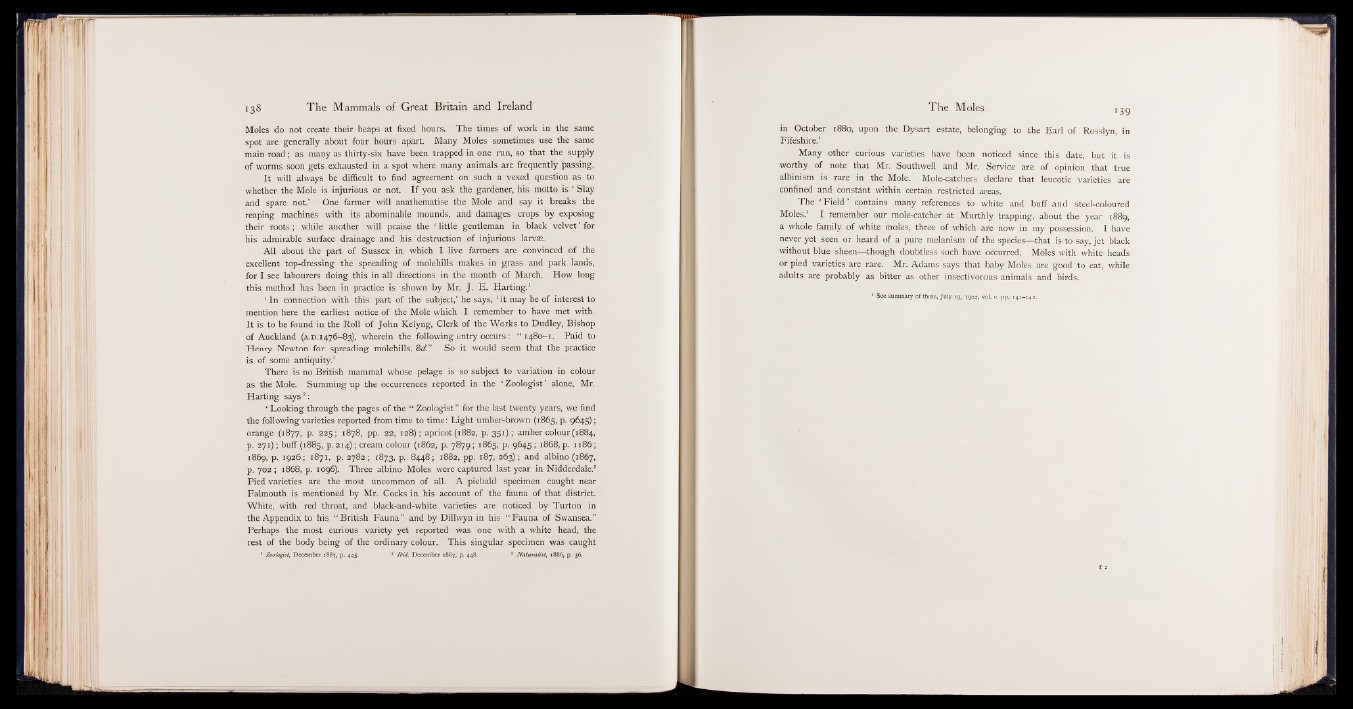
138
Moles do not create their heaps at fixed hours. The times of work in the same
spot are generally about four hours apart. Many Moles sometimes use the same
main road; as many as thirty-six have been trapped in one run, so that the supply
of worms soon gets exhausted in a spot where many animals are frequently passing.
It will always be difficult to find agreement on such a vexed question as to
whether the Mole is injurious or not. If you ask the gardener, his motto is ‘ Slay
and spare not.’ One farmer will anathematise the Mole and say it breaks the
reaping machines with its abominable mounds, and damages crops by exposing
their roots; while another will praise the ‘ little gentleman in black velvet ’ for
his admirable surface drainage and his destruction of injurious larvae.
All about the part of Sussex in which I live farmers are convinced of the
excellent top-dressing the spreading of molehills makes in grass and park lands,
for I see labourers doing this in all directions in the month of March. How long
this method has been in practice is shown by Mr. J. E. Halting.1
‘ In connection with this part of the subject,’ he says, ‘ it may be of interest to
mention here the earliest notice of the Mole which I remember to have met with.
It is to be found in the Roll of John Kelyng, Clerk of the Works to Dudley, Bishop
of Auckland (a .d . 1476-83), wherein the following entry occurs: “ 1480-1. Paid to
Henry Newton for spreading molehills, 8d.” So it would seem that the practice
is of some antiquity.’
There is no British mammal whose pelage is so subject to variation in colour
as the Mole. Summing up the occurrences reported in the ‘ Zoologist ’ alone, Mr.
Harting says2:
* Looking through the pages of the “ Zoologist ” for the last twenty years, we find
the following varieties reported from time to time : Light umber-brown (1865, p. 9645);
orange (1877, p. 225; 1878, pp. 22, 128); apricot (1882, p. 351); amber colour (1884,
p. 271); buff (1885, p. 214); cream colour (1862, p. 7879; 1865, p. 9645; 1868, p. 1186;
1869, p. 1926; 1871, p. 2782; 1873, p. 8448; 1882, pp. 187, 263); and albino (1867,
p. 702 ; 1868, p. 1096). Three albino Moles were captured last year in Nidderdale.8
Pied varieties are the most uncommon of all. A piebald specimen caught near
Falmouth is mentioned by Mr. Cocks in his account of the fauna of that district.
White, with red throat, and black-and-white varieties are noticed by Turton in
the Appendix to his “ British Fauna” and by Dillwyn in his “ Fauna of Swansea.”
Perhaps the most curious variety yet reported was one with a white head, the
rest of the body being of the ordinary colour. This singular specimen was caught
1 Zoologist, December 1887, p. 445. 3 Ibid. December 1887, p. 448. 8 Naturalist, 1886, p. 36.
in October 1880, upon the Dysart estate, belonging to the Earl of Rosslyn, in
Fifeshire.’
Many other curious varieties have been noticed since this date, but it is
worthy of note that Mr. Southwell and Mr. Service are of opinion that true
albinism is rare in the Mole. Mole-catchers declare that leucotic varieties are
confined and constant within certain restricted areas.
The ‘ Field’ contains many references to white and buff and steel-coloured
Moles.1 I remember our mole-catcher at Murthly trapping, about the year 1889,
a whole family of white moles, three of which are now in my possession. I have
never yet seen or heard of a pure melanism of the species— that is to say, jet black
without blue sheen— though doubtless such have occurred. Moles with white heads
or pied varieties are rare. Mr. Adams says that baby Moles are good to eat, while
adults are probably as bitter as other insectivorous animals and birds.
See summary of these, July 19, 1902, vol. c. pp, 141-142.